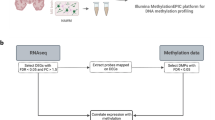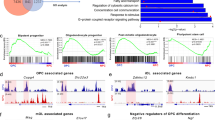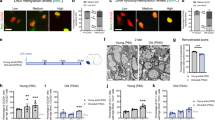Abstract
Demyelination of axons plays an important role in the pathology of many spinal cord diseases and injuries. Remyelination in demyelinated lesions is primarily performed by oligodendrocyte progenitor cells (OPCs), which generate oligodendrocytes in the developing and mature central nervous system. The efficiency of remyelination decreases with age. Many reports suggest that this decline in remyelination results from impaired OPC recruitment and differentiation during aging. Of the various molecular mechanisms involved in aging, changes in epigenetic modifications have received particular attention. Global DNA methylation is a major epigenetic modification that plays important roles in cellular senescence and organismal aging. Thus, we aimed to evaluate the dynamic changes in the global DNA methylation profiles of OPCs derived from rat spinal cords during the aging process. We separated and cultured OPCs from the spinal cords of neonatal, 4-month-old, and 16-month-old rats and investigated the age-related alterations of genomic DNA methylation levels by using quantitative colorimetric analysis. To determine the potential cause of dynamic changes in global DNA methylation, we further analyzed the activity of DNA methyltransferases (DNMTs) and the expression of DNMT1, DNMT3a, DNMT3b, TET1, TET2, TET3, MBD2, and MeCP2 in the OPCs from each group. Our results showed the genomic DNA methylation level and the activity of DNMTs from OPCs derived from rat spinal cords decreased gradually during aging, and OPCs from 16-month-old rats were characterized by global hypomethylation. During OPC aging, the mRNA and protein expression levels of DNMT3a, DNMT3b, and MeCP2 were significantly elevated; those of DNMT1 were significantly down-regulated; and no significant changes were observed in those for TET1, TET2, TET3, or MBD2. Our results indicated that global DNA hypomethylation in aged OPCs is correlated with DNMT1 downregulation. Together, these data provide important evidence for partly elucidating the mechanism of age-related impaired OPC recruitment and differentiation and assist in the development of new treatments for promoting efficient remyelination.
Similar content being viewed by others
References
Papastefanaki F, Matsas R. From demyelination to remyelination: The road toward therapies for spinal cord injury. Glia, 2015,63(7):1101–1125
Merrill JE, Scolding NJ. Mechanisms of damage to myelin and oligodendrocytes and their relevance to disease. Neuropathol Appl Neurobiol, 1999,25(6):435–458
Jennings AR, Kirilak Y, Carroll WM. In situ characterisation of oligodendrocyte progenitor cells in adult mammalian optic nerve. J Neurocytol, 2002,31(1):27–39
Back SA, Luo NL, Borenstein NS, et al. Arrested oligodendrocyte lineage progression during human cerebral white matter development: dissociation between the timing of progenitor differentiation and myelinogenesis. J Neuropathol Exp Neurol, 2002,61(2):197–211
McTigue DM, Wei P, Stokes BT. Proliferation of NG2–positive cells and altered oligodendrocyte numbers in the contused rat spinal cord. J Neurosci, 2001,21(10):3392–400
Totoiu MO, Keirstead HS. Spinal cord injury is accompanied by chronic progressive demyelination. J Comp Neurol, 2005,486(4):373–383
Sim FJ, Zhao C, Penderis J, et al. The age–related decrease in CNS remyelination efficiency is attributable to an impairment of both oligodendrocyte progenitor recruitment and differentiation. J Neurosci, 2002,22(7):2451–2459
Michikawa Y, Mazzucchelli F, Bresolin N, et al. Agingdependent large accumulation of point mutations in the human mtDNA control region for replication. Science, 1999,286(5440):774–779
Arruda LF, Arruda SF, Campos NA, et al. Dietary iron concentration may influence aging process by altering oxidative stress in tissues of adult rats. PLoS One, 2013,8(4):e61058
Wilson VL, Jones PA. DNA methylation decreases in aging but not in immortal cells. Science, 1983,220(4601):1055–1057
Shen S, Sandoval J, Swiss VA, et al. Age–dependent epigenetic control of differentiation inhibitors is critical for remyelination efficiency. Nat Neurosci, 2008,11(9):1024–1034
Jones PA, Takai D. The role of DNA methylation in mammalian epigenetics. Science, 2001,293(5532):1068–1070
Bestor TH, Edwards JR, Boulard M. Notes on the role of dynamic DNA methylation in mammalian development. Proc Natl Acad Sci USA, 2015,112(22):6796–6799
Isagawa T, Nagae G, Shiraki N, et al. DNA methylation profiling of embryonic stem cell differentiation into the three germ layers. PLoS One, 2011,6(10):e26052
Chen RZ, Pettersson U, Beard C, et al. DNA hypomethylation leads to elevated mutation rates. Nature, 1998,395(6697):89–93
Gomes MV, Toffoli LV, Arruda DW, et al. Age–related changes in the global DNA methylation profile of leukocytes are linked to nutrition but are not associated with the MTHFR C677T genotype or to functional capacities. PLoS One, 2012;7(12):e52570
Sidler C, Woycicki R, Kovalchuk I, et al. WI–38 senescence is associated with global and site–specific hypomethylation. Aging (Albany NY), 2014,6(7):564–574
Fatemi M, Hermann A, Pradhan S, et al. The activity of the murine DNA methyltransferase Dnmt1 is controlled by interaction of the catalytic domain with the N–terminal part of the enzyme leading to an allosteric activation of the enzyme after binding to methylated DNA. J Mol Biol, 2001,309(5):1189–1199
Okano M, Bell DW, Haber DA, et al. DNA methyltransferases Dnmt3a and Dnmt3b are essential for de novo methylation and mammalian development. Cell, 1999,99(3):247–257
Nan X, Cross S, Bird A. Gene silencing by methyl–CpGbinding proteins. Novartis Found Symp, 1998,214:6–16
Snape A. MBDs mediate methylation, deacetylation and transcriptional repression. Trends Genet, 2000,16(1):20
Shi J, Marinovich A, Barres BA. Purification and characterization of adult oligodendrocyte precursor cells from the rat optic nerve. J Neurosci, 1998,18(12):4627–4636
Li WW, Penderis J, Zhao C, et al. Females remyelinate more efficiently than males following demyelination in the aged but not young adult CNS. Exp Neurol, 2006,202(1):250–254
Bozdag S, Li A, Riddick G, et al. Age–specific signatures of glioblastoma at the genomic, genetic, and epigenetic levels. PLoS One, 2013,8(4):e62982
Wu H, Coskun V, Tao J, et al. Dnmt3a–dependent nonpromoter DNA methylation facilitates transcription of neurogenic genes. Science, 2010,329(5990):444–448
Espada J, Ballestar E, Santoro R, et al. Epigenetic disruption of ribosomal RNA genes and nucleolar architecture in DNA methyltransferase 1 (Dnmt1) deficient cells. Nucleic Acids Res, 2007,35(7):2191–2198
Kashiwagi K, Nimura K, Ura K, et al. DNA methyltransferase 3b preferentially associates with condensed chromatin. Nucleic Acids Res, 2011,39(3): 874–888
Wilson AS, Power BE, Molloy PL. DNA hypomethylation and human diseases. Biochim Biophys Acta, 2007,1775 (1):138–162
Agrawal A, Tay J, Yang GE, et al. Age–associated epigenetic modifications in human DNA increase its immunogenicity. Aging (Albany NY), 2010,2(2):93–100
Zhang W, Ji W, Yang J, et al. Comparison of global DNA methylation profiles in replicative versus premature senescence. Life Sci, 2008,83(13–14):475–480
Li Y, Chen G, Ma L, et al. Plasticity of DNA methylation in mouse T cell activation and differentiation. BMC Mol Biol, 2012,13:16
Ficz G, Branco MR, Seisenberger S, et al. Dynamic regulation of 5–hydroxymethylcytosine in mouse ES cells and during differentiation. Nature, 2011,473(7347):398–402
Chen H, Dzitoyeva S, Manev H. Effect of aging on 5–hydroxymethylcytosine in the mouse hippocampus. Restor Neurol Neurosci, 2012,30(3):237–245
Calvanese V, Lara E, Kahn A, et al. The role of epigenetics in aging and age–related diseases. Ageing Res Rev, 2009,8(4):268–276
Author information
Authors and Affiliations
Corresponding author
Additional information
This project was supported by grants from the National Natural Science Foundation of China (No. 81000520 and No. 81702650), the Natural Science Foundation of Hubei Province of China (No. 02.07.17040039), Innovation Foundation of Huazhong University of Science and Technology (No. 2016YXMS229) and the Innovation Foundation of Wuhan Union Hospital (No. 02.03.2017-54).
Rights and permissions
About this article
Cite this article
Zhou, J., Wu, Yc., Xiao, Bj. et al. Age-related Changes in the Global DNA Methylation Profile of Oligodendrocyte Progenitor Cells Derived from Rat Spinal Cords. CURR MED SCI 39, 67–74 (2019). https://doi.org/10.1007/s11596-019-2001-y
Received:
Revised:
Published:
Issue Date:
DOI: https://doi.org/10.1007/s11596-019-2001-y




